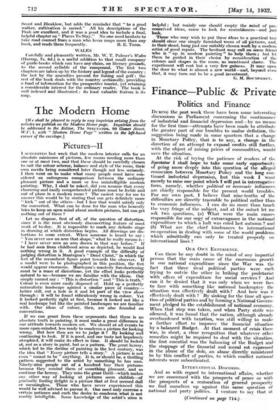The Modern Home
We shall be pleased to reply to any inquiries arising from the articles we publish on the Modern Home page. Inquiries should be addressed to the Editor, The SPECTATOR, 99 Gower Street, 1V.('.1, with "Modern Home Page" written in the left-hand corner of the envelope.]
Pictures—II
suencsran last week that the modern interior calls for an absolute minimum of pictures, few rooms needing more than one or at most two, and that these should be carefully chosen to suit the colour scheme, balance and style of the room, their own merits being considered later though not less seriously. I then went on to make what many people must have con- sidered an outrageous comparison between the ordinary pleasant picture and a more or less unintelligible modern painting. Why. I shall be asked, did you assume that every charming and easily comprehended picture must be feeble and out of place in a modem room ? The easiest way for me to answer this would he by stating that one gets definitely more kick" out of the others—but I fear that would satisfy only the converted. What can be done for the man who honestly tries to keep an open mind about modern pictures, but can get nothing out of them ?
7 Let us dispose, first of all, of the question of distortion, since it is the most obviously disconcerting feature of most work of to-day. It is impossible to mark any definite stage in drawing at which distortion begins. All drawings are dis- tortions to some extent. When someone is heard to say: You never saw an arm that shape," -what he really means is : "I have never seen an arm drawn in that way before." If he had seen from childhood arms so depicted, he would find nothing wrong in it. A good example of -the difficulty of judging distortion is Mantegna's "Dead Christ," in which the feet of the recumbent figure point towards the observer. If a model were to be photographed in this position, the feet would appear enormous. Mantegna's masterly foreshortening must be a mass of distortions, yet the effect looks perfectly natural to us—because we are familiar with the idiom. One simply cannot say : " This is distortion" and "This is truth." Colour is even more easily disposed of. Hold up a perfectly naturalistic landscape against a similar piece of country— better still, cut a hole in it and let part of the view show through : it will be found ridiculously wrong in colour. Yet it looked perfectly right at first, because it looked not like a real landscape but like the painted landscapes we are familiar with. Our ideas of colour, then, are also founded on Conventions.
• If we can grant from these arguments that there is no absolute truth in painting, it mast make a great difference in our attitude towards modem art. We should at all events be More open-minded, less ready to condemn a picture for looking wrong. But how then are we to judge it ? By looking and continuing to look. If it is good, and our taste not hopelessly atrophied, it will make its effect in time. It should be looked at, not as a story in paint, but as a pattern. The great heresy, which led to the decline of painting in the last century, was the idea that "Every picture tells a story." A picture is not even " meant to be " anything. It is, or should be, a thrilling pattern suggested to the artist by something he has seen. Ninety-nine people out of a hundred buy their pictures because they remind them of something pleasant, and so continue the heresy. They miss the great thrill—which makes any other way of looking at pictures seem childish—of gunman}, finding delight in a picture that at first seemed dull or meaningless. Those who have never experienced this would be well advised to pursue it. One need only exercise a certain patience and curb the desire to condemn what is not readily intelligible. Some knowledge of the artist's aims is helpful; but mainly one should empty the mind of pre- conceived ideas, cease to look for resemblances—and just look.
Those who may wish to put these ideas to a practical test should clear one simply furnished room of all pictures, and, in their stead, hang just one suitably chosen work by a modern artist of good repute. The hesitant may call on some friend who is "up in modem painting" to help them ; but let them be guided in *their choice by consideration of the colours and shapes in the room, as mentioned above. The experiment will cost but a very few guineas. It may open the door to what is almost a new world—and, beyond even that, it may turn out to be a good investment G. M. Bot-srenary.




































 Previous page
Previous page